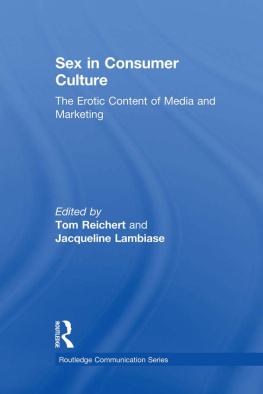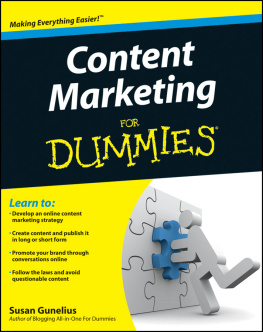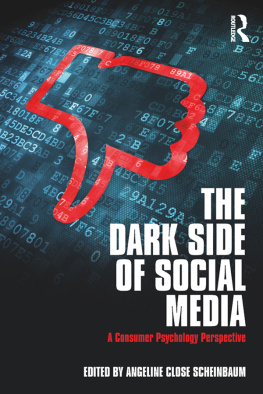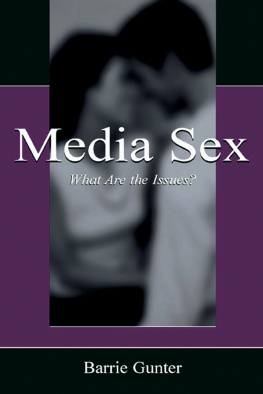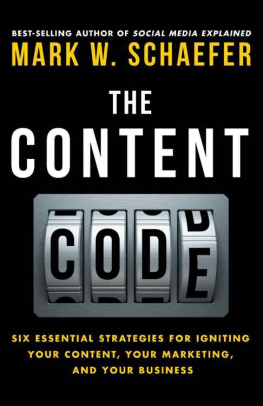SEX IN CONSUMER CULTURE
The Erotic Content of Media and Marketing
SEX IN CONSUMER CULTURE
The Erotic Content of Media and Marketing
Edited by
Tom Reichert
University of Georgia
Jacqueline Lambiase
Texas Tech University

Senior Acquisitions Editor:
Assistant Editor:
Cover Design:
Textbook Production Manager:
Full-Service Compositor: | Linda Bathgate
Karin Wittig Bates
Kathryn Houghtaling Lacey
Paul Smolenski
TechBooks |
This book was typeset in 10/12 pt. Palatino, Italic, Bold.
The titles were typeset in Franklin Gothic, Bold and heads in Palatino, Bold, Bold Italic.
Copyright 2006 by Lawrence Erlbaum Associates, Inc.
All rights reserved. No part of his book may be reproduced in
any form, by photostat, microform, retrieval system, or any
other means, without prior written permission oft he publisher.
First published by
Lawrence Erlbaum Associates, Inc., Publishers
10 Industrial Avenue
Mahwah, New Jersey 07430
This edition published 2012 by Routledge
Routledge
Taylor & Francis Group
711 Third Avenue
New York, NY 100017 | Routledge
Taylor & Francis Group
2 Park Square, Milton Park,
Abingdon, Oxon, OX14 4RN |
Library of Congress Cataloging-in-Publication Data
Sex in consumer culture: the erotic content of media and marketing /edited
by Tom Reichert, Jacqueline Lambiase.
p. cm.
Includes bibliographical references and indexes.
ISBN 978-0-8058-5090-1 (casebound: alk. paper)ISBN 0-8058-5091-0 (pbk.: alk. paper)
1. Sex in advertising. 2. Sex in mass media. I. Reichert, Tom.
II. Lambiase, Jacqueline. III. Title. IV. Series.
HF5827.85.S496 2006
659.1dc22
2005016938
Contents
| Tom Reichert and Jacqueline Lambiase |
| Mary Beth Oliver and Sriram Kalyanaraman |
| Julie Andsager |
| Stacy L. Smith and Emily Moyer-Gus |
| Jacqueline Lambiase and Tom Reichert |
| Jamie Skerski |
| Jami A. Fullerton and Alice Kendrick |
| Carol J. Pardun and Kathy Roberts Forde |
| Artemio Ramirez, Jr. |
| Jason Chambers |
| Tom Reichert and Tray LaCaze |
| Debra Merskin |
| Jonathan E. Schroeder and Pierre McDonagh |
| Jacqueline Lambiase |
| Stephen J. Gould |
| Dana E. Mastro and Susannah R. Stern |
| Diane Susan Grimes |
| Gary Soldow |
| Larry Lance |
Please allow me to begin by being subjective and waxing nostalgic. More specifically, I would like to compare and contrast the erotic environment of my childhood with that which prevails as my children reach maturity.
MY YOUTH
I grew up on a farm, so for me sexreal sex, not eroticawas an everyday part of reality. When a cow came in (i.e., reached estrus), we made sure a bull was available to service her, and we sat on the fence to watch and make sure the job was done right. We boarded a fine stallion on our farm, so the triumphant whinny that accompanied the successful mounting of a receptive filly was a regular part of my farm music. My beautiful Collie, Duchess, had more than a hundred puppies, and we never owned a male dog; so, promiscuity was a common occurrence, the primary ramification of which was that I had to find homes for more squirming fur balls than I ever want to remember. Some of our neighboring farm families had from six to 10 children. So yes, sex was rampant and birth control was largely absent; but I do not remember sex ever being an issue.
This was also the case for my personal sexual socialization. My mother was a school librarian who often used her first-born as a test reader for potentially controversial novels, so we read together and discussed with candor Betty Smith's A Tree Grows in Brooklyn, Henry Miller's Tropic of Cancer, and many other novels with sexual thema. When it came time for that talk when I was 8, my father pulled out the sex education materials he had used with military personnel preparing to go on leave in Paris after WWII, complete with audio-visual aids and canned jokes. I'll never forget his icebreaking joke about how to use a condom: You take the rubber out of its wrapper, put it on the head of your penis, and unroll ituntil you run out of penis or run out of rubber. Envision this complete with an accompanying diagram, and you'll get an accurate sense of my first birds and bees discussion.
Throughout my coming of age, real world sex was natural (which I later learned was not necessarily typical). In contrast, the symbolic media environment of that period was largely sanitized of either sex or sensuality. Consider television programming: Lucy's pregnancy (Lucille Ball, I Love Lucy, CBS, 19511957) was a delicate subject, and Rob and Laurie Petrie (Dick Van Dyke and Mary Tyler Moore, The Dick Van Dyke Show, CBS, 19611967) still slept apart in twin beds although married. The top-rated films of the 1950s were Lady and the Tramp (1955), Peter Pan (1953), Cinderella (1950), and The Ten Commandments (1956); for the 1960s, 101 Dalmatians (1961), The Jungle Book (1967), and The Sound of Music (1965) were the top draws; and for the 1970s, the top-rated movies included Star Wars (1977) and Jaws (1975). None of these movies was sexually adventurous. Books were certainly tiptoeing into the realm of erotica during this period, with James Jones's From Here to Eternity (1951) and Henry Miller's Tropic of Cancer (1961) as examples, but for the most part, the best-seller list was dominated by Daphne du Maurier, James A. Michener, Frances Parkinson Keyes, and the like. In advertising, sexuality was making some breakthroughs, such as with the Maidenform Bra campaign featuring attractive models in brassieres who dreamed they were (fill in fantasy here) in their Maidenform Bras, and Noxzema's spokeswoman with the come hither voice telling men to take it off; take it all off. Normative advertising, however, was still relatively chaste.
MY CHILDREN'S YOUTH
The sexual environment in the late 20th and early 21st centuries, when my children are reaching maturity, contrasts dramatically for the most part with my own earlier experiences in coming of age. In terms of their early exposure to real sex, we still own a farm so barnyard breeding helped provide insight into the mechanical aspects of sex. But when it came time prior to middle school for Mom and Dad to explain human sexual behavior, the media and their peers had already filled our children's minds with so many false images that our lessons were less in the service of education than in correcting misinformation. For once I found myself agreeing with Neil Postman, who proclaimed that the media were largely responsible for The Disappearance of Childhood (New York: Delacorte Press, 1982). What had happened to my children's generation is that sex had thoroughly permeated consumer culture, was so readily accessible to anyone at any age, and was so distorted by ulterior commercial motives, that commercial pandering and an incredible hypersexuality had mangled and perverted that which is natural and beautiful about sexual behavior.

